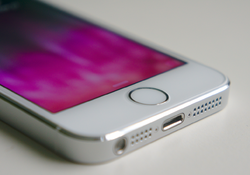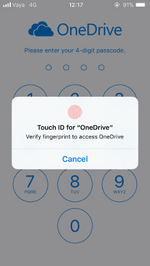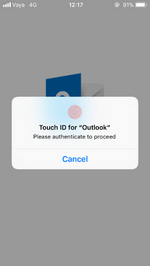Touch ID
 From HandWiki - Reading time: 10 min
From HandWiki - Reading time: 10 min
Touch ID is an electronic fingerprint recognition feature designed and released by Apple Inc. that allows users to unlock devices, make purchases in the various Apple digital media stores (iTunes Store, App Store, and Apple Books Store), and authenticate Apple Pay online or in apps. It can also be used to lock and unlock password-protected notes on iPhone and iPad. Touch ID was first introduced in iPhones with 2013's iPhone 5s,[1] In 2015, Apple introduced a faster second-generation Touch ID in the iPhone 6s; a year later in 2016, it made its laptop debut in the MacBook Pro integrated on the right side of the Touch Bar. Touch ID has been used on all iPads since the iPad Air 2 was introduced in 2014. In MacBooks, each user account can have up to three fingerprints, and a total of five fingerprints across the system.[2] Fingerprint information is stored locally in a secure enclave on the Apple A7 and later chips, not in the cloud, a design choice intended to secure fingerprint information from users or malicious attackers.
Apple retained Touch ID on iPhone 8, 2nd generation iPhone SE, 3rd generation iPhone SE, and the base model iPads, while all other iPhones since the iPhone X in 2017, and the higher-end iPad Pro have adopted Face ID recognition. The Touch ID sensor has been integrated with the sleep/wake button on several iPads: the 4th and 5th-generation iPad Air, 6th-generation iPad Mini, and the 10th-generation iPad. In 2020, 2021 and 2022, Apple unveiled a new Magic Keyboard with optional Touch ID for its line of iMacs, Mac Studios, and Mac minis, and also the MacBook Pro.
History
In 2012, Apple acquired AuthenTec, a company focused on fingerprint-reading and identification management software, for $356 million.[3] The acquisition led commentators to expect a fingerprint reading feature.[3][4] Following leaks and speculation in early September the next year,[5][6] the iPhone 5s was unveiled on September 10, 2013, and was the first phone on a major US carrier to feature the technology.[7] Apple's Vice President of Marketing, Phil Schiller, announced the feature at Apple's iPhone media event and spent several minutes (the major portion of the conference) discussing the feature.
Wells Fargo analyst Maynard Um predicted on September 4, 2013, that a fingerprint sensor in the iPhone 5s would help mobile commerce and boost adoption in the corporate environment.[8] "As consumers increasingly rely on mobile devices to transact and store personal data, a reliable device-side authentication solution may become a necessity," Um said.[8]
With the unveiling of the iPhone 6 and 6 Plus at a keynote event on September 9, 2014, Touch ID was expanded from being used to unlock the device and authenticating App Store purchases to also authenticating Apple Pay. The iPhone 6s incorporates a second-generation Touch ID sensor that is up to twice as fast as the first-generation sensor found in the 5s, 6, and SE (1st generation) phones. As of August 2022, the iPhone 6s, 6s Plus, 7, 7 Plus, 8, 8 Plus, SE (2nd generation), SE (3rd generation), 2016 and later MacBook Pro, 2018 and later MacBook Air, iPad Pro (2nd generation) and later, iPad Air (3rd generation) and later, and iPad mini (5th generation) or later are the Apple devices which use the second generation sensor. The new Touch ID unlocks almost instantly and posed an issue as it unlocks too fast to read notifications on the lock screen. This is remedied with the iOS 10 update in which a user must press the home button to have the home screen appear. This, however, can be changed in iOS settings so that users can go directly to the home screen after resting their finger on the sensor, similar to previous versions of iOS. Solely placing a finger on the sensor will only unlock the iPhone unless said setting is enabled, and no notifications are currently being displayed on the lock screen.
Generations
First generation
| Model | Announced |
|---|---|
| iPhone 5s | September 10, 2013 |
| iPhone SE (1st generation) | March 21, 2016 |
| iPhone 6 & 6 Plus | September 9, 2014 |
| iPad Pro 12.9-inch[9] | September 9, 2015 |
| iPad Pro 9.7-inch[9] | March 21, 2016 |
| iPad Air 2[9] | October 16, 2014 |
| iPad Mini 3 | |
| iPad Mini 4[9] | September 9, 2015 |
| iPad (5th generation) | March 24, 2017 |
| iPad (6th generation) | March 27, 2018 |
| iPad (7th generation) | September 10, 2019 |
| iPad (8th generation) | September 15, 2020 |
| iPad (9th generation) | September 14, 2021 |
Second generation
| Model | Announced |
|---|---|
| iPhone 6s & 6s Plus | September 9, 2015 |
| iPhone 7 & 7 Plus | September 7, 2016 |
| iPhone 8 & 8 Plus | September 12, 2017 |
| iPad Pro (2nd generation) | June 5, 2017 |
| iPad Air (3rd generation) | March 18, 2019 |
| iPad Mini (5th generation) | |
| iPhone SE (2nd generation) | April 15, 2020 |
| iPad Air (4th generation) | September 15, 2020 |
| iPad Mini (6th generation) | September 14, 2021 |
| iPad Air (5th generation) | March 8, 2022 |
| iPhone SE (3rd generation) | |
| iPad (10th generation) | October 18, 2022 |
| MacBook Pro (13-inch, 2016, Four Thunderbolt 3 ports) | October 27, 2016 |
| MacBook Pro (15-inch, 2016) | |
| MacBook Pro (13-inch, 2017, Four Thunderbolt 3 ports) | June 5, 2017 |
| MacBook Pro (15-inch, 2017) | |
| MacBook Pro (13-inch, 2018, Four Thunderbolt 3 ports) | July 12, 2018 |
| MacBook Pro (15-inch, 2018) | |
| MacBook Air (Retina, 13-inch, 2018) | October 30, 2018 |
| MacBook Pro (13-inch, 2019, Four Thunderbolt 3 ports) | May 21, 2019 |
| MacBook Pro (15-inch, 2019) | |
| MacBook Air (Retina, 13-inch, 2019) | July 9, 2019 |
| MacBook Pro (16-inch, 2019) | November 13, 2019 |
| MacBook Air (Retina, 13-inch, 2020) | March 18, 2020 |
| MacBook Pro (13-inch, 2020, Four Thunderbolt 3 ports) | May 4, 2020 |
| MacBook Air (M1, 2020) | November 10, 2020 |
| MacBook Pro (13-inch, M1, 2020) | |
| MacBook Pro (14-inch, 2021) | October 18, 2021 |
| MacBook Pro (16-inch, 2021) | |
| iMac (24-inch, M1, 2021) | Apr 20, 2021 |
| Magic Keyboard with Touch ID | |
| Magic Keyboard with Touch ID and Numeric Keypad | |
| MacBook Air (M2, 2022) | June 6, 2022 |
| MacBook Pro (M2, 2022) | |
| MacBook Pro (14-inch, 2023) | January 17, 2023 |
| MacBook Pro (16-inch, 2023) |
Hardware
Touch ID is built into the home (top) button, which is built of laser-cut[10] sapphire crystal, and does not scratch easily (scratching would prevent Touch ID from working).[11] It features a stainless steel detection ring to detect the user's finger without pressing it. There is no longer a rounded square icon in the home button, nor is it concave.
The sensor uses capacitive touch to detect the user's fingerprint.[11] The sensor has a thickness of 170 µm, with 500 pixels per inch resolution. The user's finger can be oriented in any direction and it will still be read.[3] Apple says it can read sub-epidermal skin layers,[12] and it will be easy to set up and will improve with every use.[10] The sensor passes a small current through one's finger to create a "fingerprint map" of the user's dermis. Up to 5 fingerprint maps can be stored in the Secure Enclave.
Security and privacy
Touch ID can be bypassed using passcodes set up by the user.[13]
Fingerprint data are stored on the secure enclave inside the Apple A7, A8, A8X, A9, A9X, A10, A10X, A11, A12, A12X A13, A14, A15, A16, A17 Pro processors of an iOS device, or the T1, T2 on Intel Macs, and M1, M2, M3 in the case of Macs with Apple Silicon and iPad Pro released in 2021 and later, iPad Air released in 2022 and later, and not on Apple servers, nor on iCloud. From the Efficient Texture Comparison patent[14] covering Apple's Touch ID technology:
In order to overcome potential security drawbacks, Apple's invention includes a process of collapsing the full maps into a sort of checksum, hash function, or histogram. For example, each encrypted ridge map template can have some lower resolution pattern computed and associated with the ridge map. One exemplary pattern could be a histogram of, e.g., the most common angles (e.g., a 2 dimensional (2D) array of common angles). The exemplary pattern could include in each slot an average value over a respective vector of the map. The exemplary pattern could include in each slot a sum of the values over a respective vector of the map. The exemplary pattern could include the smallest or largest value within a respective vector of the map or could be a difference between a largest and a smallest value within the respective vector of the map. Numerous other exemplary embodiments are also possible, and any other exemplary pattern calculation can be used, where the exemplary pattern includes enough associated information to narrow the candidate list, while omitting enough associated information that the unsecured pattern cannot or cannot easily be reverse engineered into a matching texture.
If the user's phone has been rebooted, has not been unlocked for 48 hours, has its SIM card removed or has Emergency SOS activated, only the passcode a user has created, not their fingerprint, can be used to unlock the device or during other specific use cases.[15][16]
In September 2013, the German Chaos Computer Club announced that it had bypassed Apple's Touch ID security. A spokesman for the group stated: "We hope that this finally puts to rest the illusions people have about fingerprint biometrics. It is plain pity to use something that you can't change and that you leave everywhere every day as a security token."[17][18] Similar results have been achieved by using PVA Glue to take a cast of the finger.[19] Others have also used Chaos Computer Club's method but concluded that it is not an easy process in either time or effort, given that the user has to use a high resolution photocopy of a complete fingerprint, special chemicals, and expensive equipment and because the spoofing process takes some time to achieve.[20]
Impact
In a 2013 New York magazine opinion piece, technology columnist Kevin Roose argued that consumers are generally not interested in fingerprint recognition, preferring to use passcodes instead. Traditionally, he wrote, only businesspeople used biometric recognition, although they believe Touch ID may help bring fingerprint recognition to the masses. Roose stated the feature will also allow application developers to experiment, should Apple open up access to Touch ID later on (which they have done), but that those wary of surveillance agencies such as the US National Security Agency may still choose not to use Touch ID.[21]
Roose also noted that fingerprint technology still has some issues, such as the potential to be hacked, or of the device's not recognizing the fingerprint (for example, when the finger has been injured).[21]
Adrian Kingsley-Hughes, writing for ZDNet, said Touch ID could be useful in bring your own device situations. He said the biometric protection adds another layer of security, removing the ability of people to look over others' shoulders and read their passcode/password. He added that Touch ID would prevent children from racking up thousands of dollars in unwanted purchases when using iPhones owned by adults. He observed that Touch ID was Apple's response to the large number of iPhone crimes, and that the new feature would deter would-be iPhone thieves. Moreover, he notes that the feature is one of the few that distinguish the iPhone 5S from the 5C.[22]
Roose also stated the feature is intended to deter theft.[21] However, Brent Kennedy, a vulnerability analyst at the United States Computer Emergency Readiness Team, expressed concern that Touch ID could be hacked and suggested that people not rely on it right away.[23] Forbes noted a history of fingerprints being spoofed in the past, and cautioned that the fingerprints on a stolen iPhone might be used to gain unauthorized access. However, the article did say that biometrics technology had improved since tests on spoofing fingerprint readers had been conducted.[23]
Kingsley-Hughes suggested the Touch ID as a form of two-factor authentication, combining something one knows (the password) with "something you are" (the fingerprint).[22] Forbes said that, if two-factor authentication is available, it will be an overall improvement for security.[23]
Forbes columnist Andy Greenberg said the fact that fingerprint data was stored on the local device and not in a centralized database was a win for security.[24]
See also
References
- ↑ "Everything you need to know about iPhone 5S's Touch ID fingerprint sensor" (in en-US). 2013-09-10. https://www.iphonehacks.com/2013/09/iphone-5s-fingerprint-touch-1d-sensor.html.
- ↑ "About Touch ID advanced security technology". 11 September 2017. https://support.apple.com/kb/HT204587.
- ↑ 3.0 3.1 3.2 Rosenblatt, Seth (September 10, 2013). "iPhone 5S comes with Touch ID fingerprint scanner". CNET. http://news.cnet.com/8301-13579_3-57602245-37/fingerprint-sensor-touch-id-unlocks-new-iphones.
- ↑ Valazco, Chris (September 11, 2013). "Apple's Touch ID Is A 500ppi Fingerprint Sensor Built Into The iPhone 5S Home Button". TechCrunch. https://techcrunch.com/2013/09/10/apples-touch-id-a-500ppi-fingerprint-sensor-built-into-iphone-5s-home-button.
- ↑ "iPhone 5S: Une photo du bouton Home avec lecteur d'empreintes digitales?!" (in fr). NowhereElse. September 3, 2013. http://www.nowhereelse.fr/bouton-home-iphone-5s-lecteur-empreintes-digitales-87919.
- ↑ "iPhone 5S: Le lecteur d'empreintes digitales confirmé?!" (in fr). NowhereElse. September 10, 2013. http://www.nowhereelse.fr/iphone-5s-lecteur-empreintes-digitales-confirme-88283.
- ↑ Newton, Casey (September 10, 2013). "Apple's new iPhone will read your fingerprint". The Verge. https://www.theverge.com/2013/9/10/4715372/confirmed-apple-iphone-5s-will-include-touch-id-fingerprint-scanner.
- ↑ 8.0 8.1 Hughes, Neil (September 4, 2013). "Fingerprint sensor in Apple's 'iPhone 5S' predicted to boost mobile commerce, enterprise adoption". AppleInsider. http://appleinsider.com/articles/13/09/04/fingerprint-sensor-in-apples-iphone-5s-predicted-to-boost-mobile-commerce-enterprise-adoption.
- ↑ 9.0 9.1 9.2 9.3 "iPad - Compare Models - Apple". 2017-02-01. https://www.apple.com/iPad/compare.
- ↑ 10.0 10.1 "Apple Announces iPhone 5S - The Most Forward-Thinking Smartphone in the World". September 10, 2013. https://online.wsj.com/article/PR-CO-20130910-909214.html.
- ↑ 11.0 11.1 "Apple announces iPhone 5S: Touch ID fingerprint security, 64-bit A7 CPU, new gold option coming Sept. 20". AppleInsider. September 10, 2013. http://appleinsider.com/articles/13/09/10/apple-announces-iphone-5s-with-64-bit-a7-cpu-new-gold-option.
- ↑ Gilbert, Ben (September 10, 2013). "iPhone 5s fingerprint sensor called Touch ID, recognizes your thumb on the Home button: here's how it works and what it does". Engadget. https://www.engadget.com/2013/09/10/iphone-5s-fingerprint-sensor.
- ↑ "Use a passcode with your iPhone, iPad, or iPod touch". 28 March 2022. https://support.apple.com/en-us/HT204060.
- ↑ "Efficient Texture Comparison". Digital. US Patent & Trademark Office. May 18, 2012. http://appft.uspto.gov/netacgi/nph-Parser?Sect1=PTO1&Sect2=HITOFF&d=PG01&p=1&u=%2Fnetahtml%2FPTO%2Fsrchnum.html&r=1&f=G&l=50&s1=%2220130308838%22.PGNR.&OS=DN/20130308838&RS=DN/20130308838.
- ↑ "Apple: New iPhone Not Storing Fingerprints, Doesn't Like Sweat". Digital. The Wall Street Journal. September 11, 2013. https://blogs.wsj.com/digits/2013/09/11/apple-new-iphone-not-storing-fingerprints-doesnt-like-sweat.
- ↑ "iOS Security Guide". March 2017. https://www.apple.com/business/docs/iOS_Security_Guide.pdf.
- ↑ Rieger, Frank (September 21, 2013). "Chaos Computer Club breaks Apple Touch ID". Chaos Computer Club. http://www.ccc.de/en/updates/2013/ccc-breaks-apple-touchid.
- ↑ Musil, Stephen (September 22, 2013). "Hackers claim to have defeated Apple's Touch ID print sensor". CNet. CBS Interactive Inc.. http://news.cnet.com/8301-13579_3-57604067-37/hackers-claim-to-have-defeated-apples-touch-id-print-sensor.
- ↑ Rogers, Marc (September 23, 2013). "Why I Hacked Apple's TouchID, And Still Think It Is Awesome". Lookout. https://blog.lookout.com/blog/2013/09/23/why-i-hacked-apples-touchid-and-still-think-it-is-awesome.
- ↑ "Why I hacked Touch ID (Again) and still think it's awesome". https://blog.lookout.com/iphone-6-touchid-hack.
- ↑ 21.0 21.1 21.2 Roose, Kevin (September 10, 2013). "Will the New iPhone's 'Touch ID' Feature Finally Make Fingerprint Scanning Happen?". New York. http://nymag.com/daily/intelligencer/2013/09/will-apples-touch-id-make-fingerprints-happen.html.
- ↑ 22.0 22.1 Kingsley-Hughes, Adrian (September 10, 2013). "iPhone 5S with Touch ID is a big win for BYOD security". http://www.zdnet.com/apples-touch-id-is-a-big-win-for-byod-security-7000020499.
- ↑ 23.0 23.1 23.2 Greenberg, Andy (September 10, 2013). "Apple's New iPhone 'Touch ID' Makes Fingerprint Scans Easy, But Don't Ditch Passcodes Yet". Forbes. https://www.forbes.com/sites/andygreenberg/2013/09/10/apples-new-iphones-touch-id-makes-fingerprint-scans-easy-but-dont-ditch-your-passcode-yet.
- ↑ Steinberg, Joseph (September 13, 2013). "Your New iPhone Can Put Your Identity At Risk". Forbes. https://www.forbes.com/sites/josephsteinberg/2013/09/13/your-new-iphone-can-put-your-identity-at-risk/.
External links
- – official site
- – official site
- – official site
 |
 KSF
KSF





